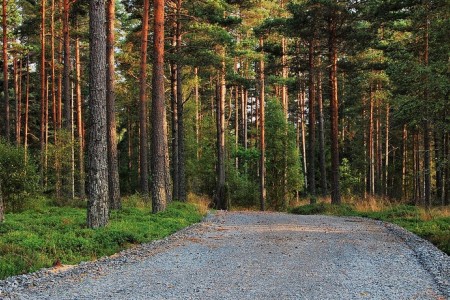Land Trusts Talk Carbon at Rally Conference

It’s no secret that land trusts nationwide are facing dwindling grant-funding sources for their land-acquisition work. They are being pushed to test new forms of financing. At Rally 2017: National Land Conservation Conference, which ran from Oct. 25-28 in Denver, three land trusts shared their experiences with one of these new tools – selling forest-carbon credits.
Land trust staff highlighted their process of weighing the risks of participation in a new marketplace with the reward of additional funding for their work.
Staff from the Downeast Lakes Land Trust (DLLT), Appalachian Mountain Club (AMC), and Lakes Region Conservation Trust (LRCT), all based in New England, provided insights into the intricate process of selling forest-carbon-offset credits.
The work of these organizations is also featured in a recent Highstead Foundation report, “New England Conservation Pathways: A Survey of Emerging Conservation Finance Strategies.”
Erin Heskett, director of national and regional services at LTA, moderated the Rally panel. LTA has identified participation in carbon markets as a component of its new Land and Climate Initiative.
Dylan Jenkins, VP of portfolio development at Finite Carbon, a forest carbon project developer, was also on the panel. Finite Carbon worked with both DLLT and LRCT to assist them in selling their credits.
According to the Highstead report, there are several types of carbon offset projects. But Improved Forest Management (IFM) projects are “the most viable forest carbon offset type for advancing land protection,” within New England where the report is focused. The projects highlighted during the Rally panel were IFM projects.
The report said that with IFM projects, woodland owners can sell offsets by committing to maintain the carbon stocks on their land above the average regional level. These average levels are established using information from the United States Forest Service’s Forest Inventory and Analysis data.
Buyers and sellers sign a contract that commits the landowner to a specific carbon-stocking level, often for a 100-year period, in exchange for a given price-per-ton for the carbon dioxide stored. Once an agreement is made, landowners can continue to manage their land for forest products but must ensure their onsite carbon stocks do not fall below the level for which they were paid.
Three Unique Land Trusts Demonstrate Similar Outcomes
David Publicover, senior staff scientist at AMC, presented on his organization’s experience selling forest-carbon credits on 10,000 acres of its Katahdin Iron Works property in Maine.
AMC’s experience was unique because it did not work with a project developer like Finite Carbon. Instead, it chose to develop projects in-house.
“We were in the process of developing a forest-carbon-offset project at the same time we were learning how to do [it],” Publicover said.
Publicover said an added challenge came halfway through the project-development process when AMC realized that a conservation easement on the property prohibited sales of credits into the regulatory market.
Instead, AMC was only able to sell credits through the “voluntary market,” which typically pays lower prices, Publicover said. Despite the changes to the financial modeling, AMC moved forward with the project and has been able to use the funds earned on Katahdin Iron Works to purchase additional conservation lands in Maine.
Unlike AMC, DLLT is quite small. The organization serves a community of around 100 year-round residents with only four staff. Nevertheless, according to its executive director, David Montague, staff have sold forest carbon credits as a part of two projects, bringing in over $4 million in revenue to support their forest-acquisition work.
Montague said, “As a tool for generating unrestricted funds, which of course is always the gold standard you’re chasing as a land trust… [this type of project has been] a great opportunity for us and has worked very well.”
DLLT has completed two projects, Montague said. The first one leveraged already conserved lands to bring in unrestricted revenue. The second used carbon-credit revenue as a component of project financing for acquisition. On both of the projects, DLLT worked with Finite Carbon as the developer.
For their second project, Montague said, the organization worked with the seller of a parcel of land, Lyme Timber Company, to develop a carbon project that would help fund the organization’s purchase of the land.
Of the total $19 million needed for acquisition of the 22,000-acre property, $4 million came through the sale of carbon credits on the property, Montague said. He added that the organization is currently working on a third carbon-credit offering on the same parcel of land as their first project. DLLT expects this additional offering to bring in over $1 million in additional revenue to put toward future conservation.
Lisetta Silvestri, operations director at LRCT, shared her experience developing what could be the first aggregate IFM carbon-offset sale in the United States if completed. Although still underway, the project will combine offsets from land owned by LRCT with offsets from lands owned by a local family.
Silvestri said that while LRCT originally approached the project as a tool to help the local family retain their forest holdings, staff realized during the feasibility process that “this would be … an incredible opportunity to store away some money for stewardship.”
While they are still in the offering phase of the project, LRCT staff anticipate raising around $2 million to put into their stewardship fund and towards their other work. They believe this project will provide a model for future aggregate projects in the carbon-credit marketplace.
Rewards Outweighed Risks for These Projects
All members of the panel emphasized the risk-tolerance of an organization as an important determinant of participation in the markets.
All of the panelists discussed at various points during the presentation the fact that prices can be volatile, financial modeling can be challenging, and there is, to some extent, a general level of uncertainty about the future existence of these programs. Organizations are making agreements – usually with 100-year terms – that will commit them to management practices far into the future.
The presentation highlighted these risks but also the fact that many land trusts may be well-positioned to participate in these programs. According to the Highstead report, “for well-stocked forests, carbon offset revenues are in addition to regular timber-harvest revenues, making them a natural partner for investor-led working forests and conservation-focused landowners alike.”
According to Spencer Meyer, coauthor of the report, the three projects highlighted at Rally provide examples of promising ways for land trusts to finance land conservation. Each presenter on the panel was pleased with the outcomes of their projects and anticipated continuing to participate in carbon-offset markets in the future.
Note: Spencer Meyer is a website leadership team member of Conservation Finance Network.
To comment on this article, please post in our LinkedIn group, contact us on Twitter, or email the author via our contact form.
